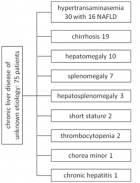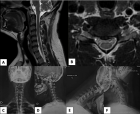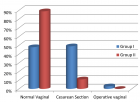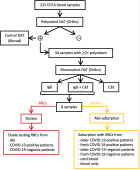Table of Contents
Nephrotic syndrome in children during the COVID-19 pandemic
Published on: 23rd August, 2022
OCLC Number/Unique Identifier: 9597893068
The COVID-19 pandemic resulted in public health measures and fewer viral infections, which trigger the nephrotic syndrome. Our objectives were to characterize the effect of the COVID-19 pandemic on children with nephrotic syndrome. This single-center retrospective chart review compared children with nephrotic syndrome one year before the pandemic with the first wave of the pandemic. Epidemiologic events, clinical characteristics, and health care utilization were compared using paired t-tests, Fisher’s exact tests and Wilcoxon Rank Sum tests. Among 96 children the mean age was 10.7 ± 5.28 years. The distribution was minimal change disease (16.7%), focal segmental glomerulosclerosis (12.5%), membranous nephropathy (1%) and not biopsied (69.8%). Medication responsiveness was steroid-sensitive (25%), frequently relapsed (54%) and steroid-resistant (20.8%). There were 14 new diagnoses of nephrotic syndrome pre-pandemic and 18 during the pandemic. Fewer relapses during the pandemic were likely due to fewer viral illnesses from public health measures during the pandemic.
Incidence, risk factors, and outcomes of acute kidney injury among hiv positive medical admissions at the Bamenda Regional Hospital
Published on: 16th June, 2022
OCLC Number/Unique Identifier: 9538011570
Background: There is a paucity of data on the burden of acute kidney injury (AKI) in hospitalized HIV-infected patients in Sub-Saharan Africa in the “test and treat” era.Objectives: To study the incidence, risk factors, and outcomes of AKI among HIV-positive medical admissions in a secondary hospital.Materials and methods: We prospectively screened adult HIV-positive patients who gave their informed consent and were admitted to the Bamenda Regional Hospital for AKI from February to June 2020. We excluded participants with Chronic Kidney Disease (CKD) Stage 5 and those with confounders of serum creatinine. On admission and after 2-7 days, we extracted a venous blood sample from each participant to evaluate serum creatinine and diagnose AKI. The participants were then followed up on until they were discharged or died. We measured the need for dialysis, access to dialysis, and renal recovery at three months for patients with AKI. The amended KDIGO 2012 criteria were used to define and classify AKI. The University of Bamenda’s institutional review board provided ethical approval.Results: A total of 206 participants (39.8% men) were enrolled, with a mean (SD) age of 45.71(13.13) years. On enrolment, 89.8% (n = 185) of the participants were on combination antiretroviral therapy (c-ART), with 81.6% (n = 151) on tenofovir-containing regimens. The WHO HIV clinical stages 3 and 4 were present in 81.5% (n = 168) of the individuals. The most common reason for hospitalization was opportunistic infections (69.8%; n = 142). AKI was found in 30.6% (n = 63) of the patients, with 58.7% (n = 37) of them being classified as KDIGO stage 3. A total of 12 (42.9%) participants out of the 28 in need, were dialyzed. AKI was independently associated with use of traditional medicines (aOR = 2.9; 95% CI 1.4-6.3; p = 0.006), WHO HIV stages 3 and 4 (aOR = 4.1; 95% CI 1.1-15.7; p = 0.038), hypotension (aOR = 3.3; 95% CI 1.4-7.8; p = 0.008) and low haemoglobin level ≤ 8.0 g/dl (aOR = 3.5; 95% CI 1.7-7.4; p = 0.001). The AKI group used to have a significantly higher mortality rate (42.9% vs. 16.1%; p < 0.001). Renal recovery was complete in 66.7% of the 30 survivors at three months, partial in 13.3%, and no recovery in 20% of the survivors.Conclusion: Despite the growing use of combination antiretroviral medication, significant immunosuppression is still common in hospitalized HIV-positive patients, increasing the risk of AKI and worsening prognosis. In this high-risk population, early detection of AKI with renal function monitoring may improve results.
Primary central nervous system lymphoma post kidney transplantation: a case report
Published on: 3rd June, 2022
Introduction: Primary central nervous system (PCNS) posttransplant lymphoproliferative disease (PTLD) is a rare complication of solid organ transplantation and treatment is not yet standardized.Case presentation: Here we report the case of a 54-year-old man who underwent renaltransplantation 22 years ago for end-stage renal disease. He had been on long-term immunosuppressive treatment consisting of orally administered prednisolone 10 mg and then 5 mg daily and orally administered Mycophenolate Mofetil 500 mg twice daily. He presented in January 2019 to emergency with aphasia and then partial seizure. On brain MRI there was an expansive cortical mass in the left temporal lobe with perilesional edema. Biopsy revealed a diffuse large B-cell lymphoma. He was treated with one cycle of Cytarabine with his usual immunosuppressive treatment. In view of his renal allograft, he was not suitable for Methotrexate due to the risk of toxicity. He died on day 15 caused by a sepsis choc secondary to febrile neutropenia.Conclusion: PCNS-PTLD is regarded as one of the most serious posttransplant complications due to its high mortality. Further clinical and experimental investigations are required to develop optimal diagnostic and treatment modalities.
Persistent symptomatic hyponatremia post-COVID 19: case report
Published on: 16th May, 2022
OCLC Number/Unique Identifier: 9524461908
Background: Hyponatremia associated with COVID-19 is considered an independent risk factor for a prolonged hospital stay, intensive care admission, and death, but its causes and treatment are not yet well known. Many workers attribute hyponatremia associated with COVID-19 to acute kidney injury and nephropathy associated with the disease. Others suggest that it is related to the syndrome of inappropriate antidiuretic hormone secretion, sepsis, or hypothalamic-pituitary dysfunction. We report a case of persistent acute hyponatremia in a COVID-19 patient with multifactorial etiology. Case presentation: A managed 77 years with known hypertension, type II DM, ischemic heart disease, chronic kidney disease (stage 3B and on treatment) presented with post-COVID-19 pneumonia, confusion, fever, generalized fatigability, dizziness, and lower limb edema. COVID-19 ad has been diagnosed two weeks earlier with a positive nasopharyngeal swab and was managed with dexamethasone, 10 mg oral for 10 days, azithromycin, 500 mg once orally, and levofloxacin, 500 mg once orally. At presentation, laboratory investigation showed hyponatremia (127.7 mg/dl). Conclusion: The etiology of hyponatremia associated with COVID-19 is different from that in other cases of hyponatremia and its management should be individualized according to patient history and clinical assessment, and effort is needed to determine the exact cause.
An update on the approaches of avoidance of propagation of chronic kidney disease resulting in reversal or possible need or avoidance of kidney transplantation - a systematic review
Published on: 10th May, 2022
Chronic Kidney Disease (CKD) by definition is a disease characterized by irreversible elimination of renal function, which keeps propagating as corroborated by an estimated glomerular filtration rate (eGFR) of < 60 ml/min/1.73m2, the constant existence of presentation which pointed to Kidney injury (proteinuria, active sediments of urine, histological injury, structural aberrations or prior history with regards to Kidney transplantation) or both that are persistent for greaterthan 3 mths [1].

HSPI: We're glad you're here. Please click "create a new Query" if you are a new visitor to our website and need further information from us.
If you are already a member of our network and need to keep track of any developments regarding a question you have already submitted, click "take me to my Query."

























































































































































